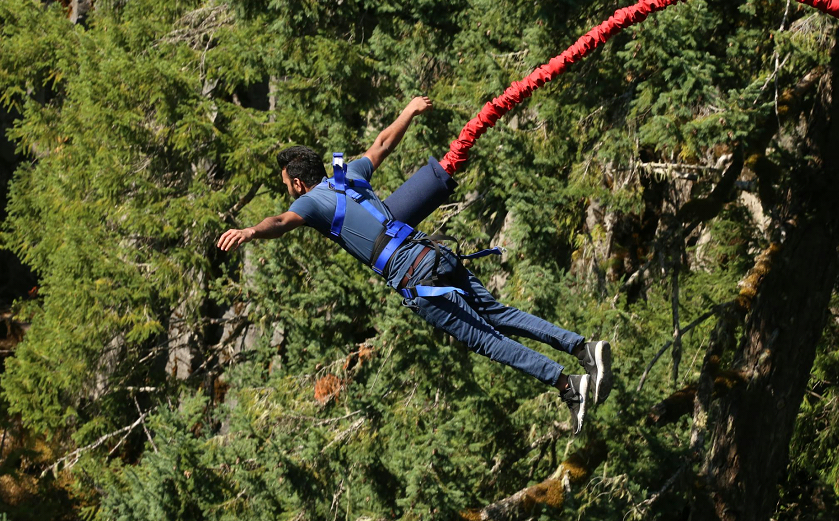The Science of Thrill-Seeking
The human body is a complex orchestra of interconnected systems, each vital to our survival and well-being. At the heart of this intricate machinery lies the adrenal gland,
a small but mighty organ that produces a potent chemical messenger known as adrenaline. Also referred to as epinephrine, adrenaline is a hormone and neurotransmitter that orchestrates a symphony of physiological responses, preparing the body for action when faced with a perceived threat or challenge.
The Adrenaline Rush: A Biological Marvel
When confronted with a stressful or exciting situation, the brain’s amygdala, the emotional processing centre, sends signals to the hypothalamus. This region acts as the body’s command centre, initiating a cascade of hormonal responses. The hypothalamus stimulates the pituitary gland, which signals the adrenal glands to release adrenaline into the bloodstream.
As adrenaline surges through the body, it binds to specific receptors on various cells, triggering a rapid-fire series of physiological changes. The heart rate accelerates, pumping blood more efficiently to the muscles. Blood pressure rises, diverting blood flow from non-essential organs toward the brain, heart, and skeletal muscles.
Airways dilate to maximise oxygen intake, and the liver releases glucose into the bloodstream, providing a quick energy boost. Pupils dilate to enhance visual acuity, and the senses become heightened, allowing for a more acute awareness of the environment.
The Evolutionary Roots of Thrill-Seeking
The human species has evolved over millions of years, adapting to a constantly changing environment. In the harsh realities of our ancestral past, survival depended on the ability to respond swiftly and effectively to threats. Those individuals with a heightened sense of alertness and willingness to take risks were likelier to evade predators, secure food, and reproduce.
Once a vital component of the fight-or-flight response, the adrenaline rush has been co-opted by the brain as a reward system. Engaging in activities that trigger the release of adrenaline can provide a sense of accomplishment, mastery, and euphoria. This evolutionary legacy explains why humans are drawn to challenges and experiences that push the boundaries of their comfort zone.
The Psychology of Thrill-Seeking
While the biological underpinnings of adrenaline are well understood, the psychological factors that drive thrill-seeking behaviour are more complex and multifaceted. Numerous theories have been proposed to explain why some individuals crave intense experiences while others prefer a more subdued lifestyle.
Optimal Arousal Theory
The optimal arousal theory, proposed by psychologist Robert Yerkes and physiologist John Dodson, suggests that humans seek an optimal level of arousal. When we are bored or understimulated, we tend to seek out activities that increase our arousal level. Conversely, when we are overwhelmed by stress or anxiety, we may engage in calming activities to reduce arousal. The goal is to maintain a balance between boredom and overstimulation.
Sensation Seeking
Marvin Zuckerman introduced sensation-seeking as a personality trait characterised by a desire for novel, varied, and complex experiences. Sensation seekers actively pursue thrills and adventures, often exhibiting a risk tolerance. Both genetic and environmental factors influence this trait.
Fear of Missing Out (FOMO)
The fear of missing out on exciting experiences can be a powerful motivator in today’s interconnected world. Social media platforms constantly bombard us with images of others enjoying thrilling adventures, creating a sense of urgency to participate in similar activities. FOMO can drive individuals to engage in risk-taking behaviours to keep up with their peers.
The Role of Gambling in Adrenaline Seeking
Gambling, in its various forms, offers a unique blend of excitement, risk, and potential reward. The anticipation of winning and the fear of losing can create a potent cocktail of emotions that trigger the release of adrenaline. The spinning roulette wheel, the turn of a poker card, or the dice roll all contribute to the uncertainty and excitement that drive the gambling experience. For example, if you Play Blackjack Online at FanDuel Casino, the rush of whether the bet wins will trigger an adrenaline rush for the player.
The Role of Dopamine
While adrenaline is the primary neurotransmitter in the fight-or-flight response, dopamine plays a crucial role in the reward system. Dopamine is released in anticipation of pleasure and reinforces behaviours that lead to reward. The combination of adrenaline and dopamine creates a potent neurochemical cocktail that drives the thrill-seeking experience.
The Benefits of Adrenaline
Beyond the immediate thrill, engaging in adrenaline-inducing activities can offer a range of psychological and physiological benefits.
⦁ Stress Reduction: Paradoxically, exposure to controlled stressors can help reduce stress levels. The body learns to cope with challenges, building resilience and adaptability.
⦁ Increased Confidence: Overcoming fears and pushing personal boundaries can boost self-esteem and confidence.
⦁ Improved Mood: The release of endorphins, another hormone associated with pleasure, can contribute to a sense of well-being and happiness.
⦁ Enhanced Creativity: Some studies suggest that adrenaline can stimulate creativity and problem-solving abilities.
⦁ Physical Health Benefits: Regular physical activity, often associated with adrenaline-inducing activities, can improve cardiovascular health, strengthen muscles, and boost the immune system.
The Dark Side of Adrenaline
While the pursuit of thrills can be exhilarating, it’s essential to recognize the potential risks and consequences. Engaging in extreme activities without proper training or equipment can lead to severe injuries or even death. Addiction to the adrenaline rush can also have negative consequences, such as financial problems, relationship difficulties, and impaired judgment.
Finding a healthy balance between seeking excitement and maintaining safety is essential. Setting realistic goals, choosing activities that match your skill level, and using proper safety equipment are crucial steps in minimising risks.
The Psychology of Fear
Fear is a fundamental human emotion that plays a complex role in thrill-seeking behaviour. On one hand, fear can be a powerful motivator, driving individuals to confront their anxieties and push their limits. On the other hand, excessive fear can paralyse and prevent people from engaging in desired activities.
Understanding the psychology of fear can help individuals develop strategies for overcoming their anxieties. Cognitive-behavioural therapy, exposure therapy, and mindfulness techniques can effectively manage fear and build confidence.
Adrenaline-Inducing Activities
The world offers many activities to satisfy the thrill-seeker’s appetite. From extreme sports to everyday adventures, there’s something for everyone.
⦁ Extreme Sports: Skydiving, bungee jumping, rock climbing, and snowboarding offer intense physical challenges and unparalleled adrenaline rushes.
⦁ Adventure Sports: Hiking, camping, white-water rafting, and kayaking provide opportunities to connect with nature and experience the thrill of the unknown.
⦁ Motorsports: Racing cars, motorcycles, or boats can be incredibly exhilarating, offering a blend of speed, competition, and risk.
⦁ Urban Exploration: Exploring abandoned buildings, tunnels, or rooftops can provide a sense of adventure and discovery.
⦁ Virtual Reality Experiences: Immersive virtual reality games can simulate the feeling of danger and excitement without the physical risks.
Final Words
The craving for adrenaline is a complex interplay of biology, psychology, and environment. Understanding the science behind this powerful force can help us appreciate the thrill-seeking experience while recognizing potential risks and rewards. Finding a healthy balance and engaging in activities that align with our personal goals and limitations can help you harness the power of adrenaline to enhance our lives.






